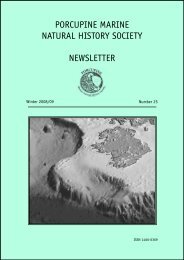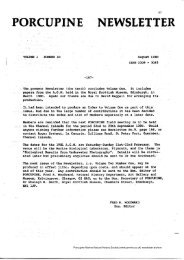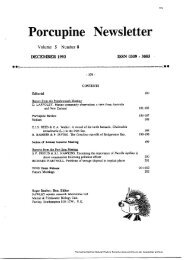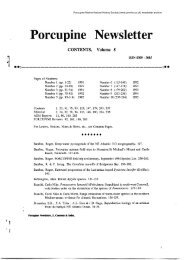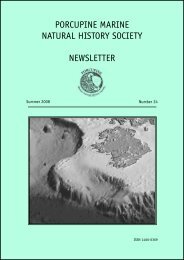Porcupine Newsletter - Porcupine Marine Natural History Society
Porcupine Newsletter - Porcupine Marine Natural History Society
Porcupine Newsletter - Porcupine Marine Natural History Society
Create successful ePaper yourself
Turn your PDF publications into a flip-book with our unique Google optimized e-Paper software.
Naming of the copepod<br />
genera Temora and<br />
Oithona<br />
Frank Evans<br />
15 Thirlmere Avenue, North Shields NE30 3UQ<br />
frankevans@zooplankton.co.uk<br />
Nowadays it is the usual practice, when<br />
awarding a scientific name to a new genus<br />
or species, to indicate in the description the<br />
meaning or significance of the chosen name.<br />
This has not always been so. Sometimes<br />
the reference is obvious as, for example, in<br />
the Linnaean copepod genus Monoculus where<br />
the reference to a single eye is clear. But from<br />
Marshall and Orr (1955) we learn that the name<br />
Calanus, formerly Monoculus, is derived from<br />
a saying of “a Jain ascetic, one of a strict and<br />
ancient sect which abhorred possessions so<br />
much that its members gave up even clothing.<br />
He followed in the train of Alexander the Great<br />
from India to Baghdad and there walked living<br />
into the pyre because his life had become<br />
worthless to him from illness.” Leach, who<br />
gave the name Calanus to the copepod in 1819<br />
described none of this.<br />
The names of two other planktonic<br />
copepod genera, both common in our waters,<br />
are traced here. The first, Oithona, was given by<br />
Baird in 1843 (Baird 1843, p.59). The second,<br />
Temora, also by Baird, was given in 1850 (Baird,<br />
1850, p.227). William Baird (1803-1872)<br />
(Davis, 1983; DNB, 2004) was a Scot, born in<br />
Eccles, Berwickshire where his father was the<br />
minister of the parish kirk. After schooling in<br />
Edinburgh he studied medicine in Edinburgh,<br />
Dublin and Paris. In 1823 he became a surgeon<br />
with the East India Company, making a total of<br />
five voyages to India and China before coming<br />
ashore in 1829. He developed a keen interest in<br />
natural history and having left the sea and set<br />
up in private practice, he helped to establish<br />
(with Dr. Johnstone) the famous Berwickshire<br />
<strong>Natural</strong>ists Club, a club which still survives and<br />
thrives. From 1833 to 1841 he had a medical<br />
practice in London.<br />
He was a zoologist of considerable ability,<br />
publishing in the journals of the Zoological<br />
and Linnaean Societies and elsewhere. In 1841<br />
he accepted an appointment in the zoological<br />
department of the British Museum. From there<br />
his establishment of the genus Temora referred<br />
to above appeared in his major Ray <strong>Society</strong><br />
publication of 1850 (Baird, 1850, p.227). He<br />
was elected to the Royal <strong>Society</strong> in 1867.<br />
The names Oithona and Temora come from<br />
an unlikely source, The Poems of Ossian. These<br />
prose poems, occupying over four hundred<br />
pages of a modern republication, were collected<br />
from Highland material extending back to<br />
the third century, translated, rewritten,<br />
embellished and to an unknown extent simply<br />
made up by James Macpherson (1736-1796).<br />
Ossian, the warrior bard and supposed creator<br />
of the poems, was the son of Fingal, a Scottish<br />
king really derived from the legendary Irish<br />
chieftain Finn MacCoul. Fingal’s kingdom<br />
was translated from Ireland into north west<br />
Scotland in the narrative. Historically the Scots<br />
came from Ireland and displaced the native<br />
Picts. The enigmatic texts created a great<br />
sensation on their first appearance in 1862<br />
and were especially welcomed in Macpherson’s<br />
native Scotland but were denounced by Dr.<br />
Johnson among others, as the concoctions<br />
of a charlatan. Yet according to Howard<br />
Gaskill (1996), regardless of their validity the<br />
chronicles are one of the most important and<br />
influential literary works ever to have emerged<br />
from these islands. They have undoubtedly had<br />
a major effect on subsequent writers. Clearly<br />
they had an effect on Dr. William Baird.<br />
Oithona splendens (nov.)and Oithona<br />
plumifera (nov.). Baird, 1843.<br />
PMNHS <strong>Newsletter</strong> No.19 Feb 2006 7<br />
7<br />
PORCUPINE PIECES<br />
<strong>Porcupine</strong> <strong>Marine</strong> <strong>Natural</strong> <strong>History</strong> <strong>Society</strong> (www.pmnhs.co.uk) newsletter archive



